12 Traditional Vegetarian Dishes To Try In Portugal
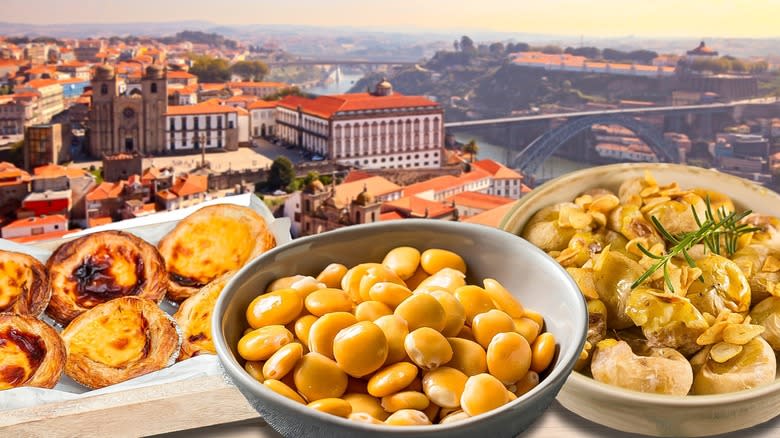
Traditional Portuguese cuisine may be best known for its meat and seafood, but there's far more to this country's culinary culture than bacalhau and bifanas. Although many specialties are indeed based on fish, chicken, and red meat, there are also plenty of traditional vegetarian Portuguese dishes to be found everywhere from Porto to the Algarve.
Overall, Portugal is a very vegetarian-friendly country; Lisbon has even been named one of the world's best cities for vegans. This is mostly due to the growing number of specifically vegan and vegetarian restaurants across the country, as well as the increasing availability of meat-free options at supermarkets. But those places and products don't necessarily reflect authentic Portuguese culinary traditions — and they're still far from the norm.
If you're visiting or living in Portugal as a vegetarian, it's important to have some knowledge of the veggie-friendly dishes that have been served here for centuries. There's a strong chance that you'll find yourself at a traditional tasca (casual restaurant) or café at some point, and you'll need to know what to order. Plus, tasting traditional foods is one of the best ways to get to know the local culture — and you don't have to miss out on that just because you don't eat meat.
Read more: 25 Most Popular Snacks In America Ranked Worst To Best
Peixinhos Da Horta
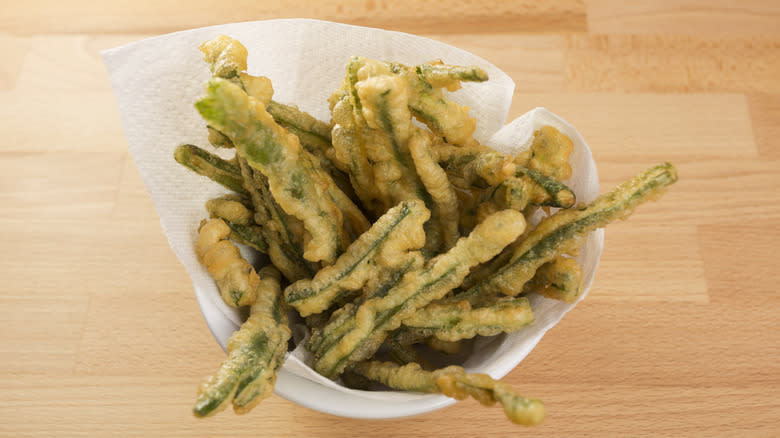
The name of this beloved dish roughly translates to "little fish from the vegetable garden." Of course, fish don't grow in the garden, so it should come as no surprise that peixinhos da horta are completely seafood-free. Instead, they're made from green beans (and sometimes other vegetables) that are coated in a light batter and fried until crispy.
The taste and texture of peixinhos da horta might remind you of vegetable tempura, which is no coincidence. Japanese tempura actually has its roots in Portuguese cuisine; Portuguese navigators introduced this cooking technique to Japan in the 1500s. Back in their home country, it was common to eat deep-fried vegetables during Lent as an alternative to meat. The method caught on and eventually transformed into the Japanese tempura we know today.
In Portugal, peixinhos da horta are commonly served as an appetizer or petisco (small snack). If you want to try ordering them in Portuguese, keep in mind that the "x" is pronounced like "sh" and the "h" in "horta" is silent. While you can count on this dish being vegetarian, it may or may not be vegan, as the batter sometimes (but not always) contains egg.
Azeitonas
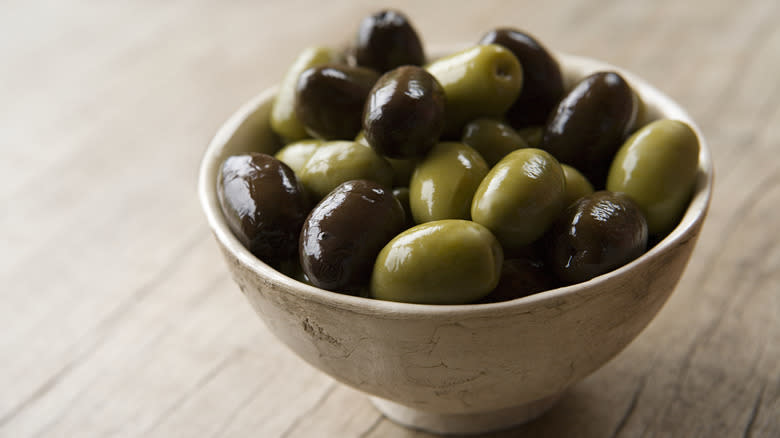
When it comes to vegetarian Portuguese food, it doesn't get much simpler than azeitonas (olives). Both olives and olive oil are integral to the local cuisine, and Portugal produces a truly enormous amount of both, considering its small size. Olives are often served at restaurants as part of the couvert: an array of small starters that are placed on the table soon after you arrive.
Dozens of types of olives are grown in Portugal, so you never know quite what you're going to get. You might be served a medley of different varieties, possibly marinated with herbs and garlic. You'll also find a wide array of olives at any supermarket or gourmet shop. Look for little individual plastic pouches of them for an easy snack or even a simple souvenir. One important thing to remember is that Portuguese olives almost always have pits, so be careful when biting into them. If you're at a restaurant, they'll usually provide a small empty dish for you to place the pits in.
Cenouras à Algarvia
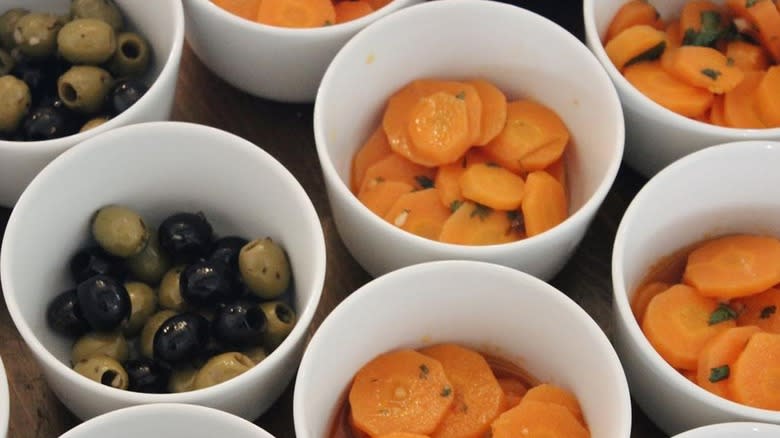
The origin of this dish is evident from its name, which means "Algarve-style carrots." The southern Algarve region of Portugal is famous for its golden cliffs and idyllic beaches but also (to a lesser extent) for this simple vegetarian starter. Cenouras à algarvia are essentially a marinated carrot salad, often served as a light and refreshing snack before a meal.
The carrots are first cooked whole, then sliced into bite-sized round pieces. After cooling off, they're tossed with olive oil, vinegar, garlic, salt, pepper, and herbs like parsley or cilantro. The key is to let them sit for long enough to soak up all the flavor before serving. If you like the combination of sour, salty, and slightly sweet flavors, you'll love cenouras à algarvia. This dish is both vegetarian and vegan by default, so there's no need to check before ordering. It's a great way to add a pop of color and some extra veggies to a traditional Portuguese meal and is widely available not only in the Algarve but throughout the whole country.
Arroz De Tomate
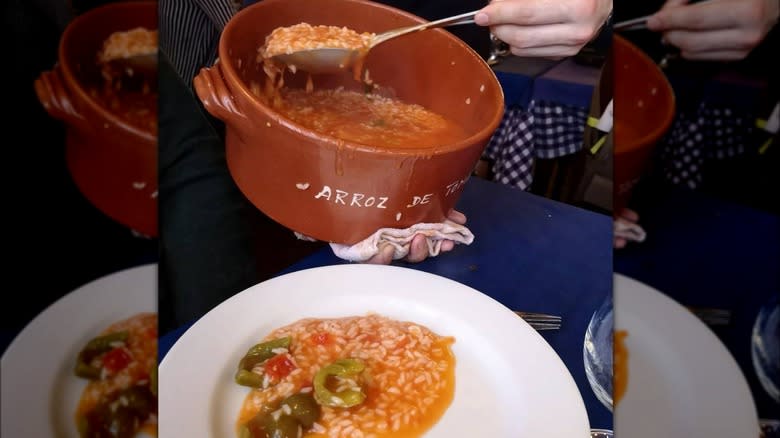
If you speak even a little bit of Portuguese, you'll know right away that this dish involves the classic combination of rice and tomatoes. Literally meaning "tomato rice," Portuguese arroz de tomate is a soupy concoction seasoned with garlic, onion, peppers, fresh herbs, and plenty of olive oil. The rice in question is usually short-grain carolino rice, which is native to Portugal. It's similar to the kind you might find in other iconic rice dishes like risotto or paella — but different from the long-grain rice used to make arroz de pato (another famous, but not vegetarian, Portuguese rice dish).
This super traditional specialty is often served as a side dish with fish, so you can find it at many authentic tascas and seafood restaurants. When ordering it, just make sure that you're getting basic arroz de tomate, not one of the many seafood- or meat-based Portuguese rice dishes. You can also try arroz de coentros (cilantro rice), arroz de feijão (rice with kidney beans), or — when all else fails — the ubiquitous plain white rice with salt and oil.
Milho Frito
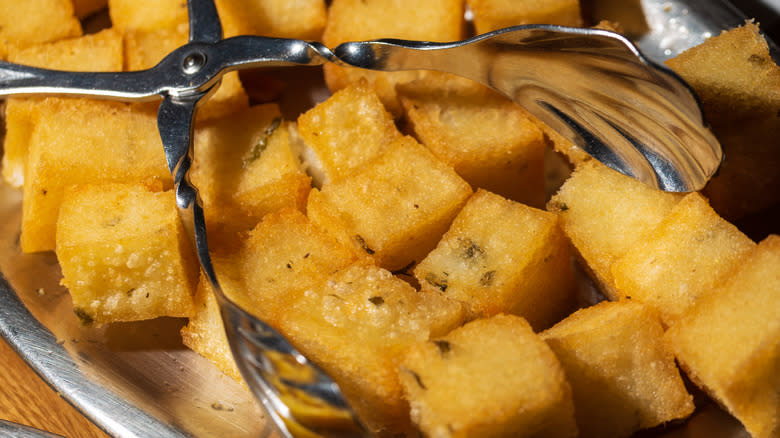
This is a typical dish from the Portuguese island of Madeira, which has plenty of its own unique culinary specialties. Milho frito means "fried corn," but we're not talking about corn on the cob or even kernels. It consists of small rectangular pieces of cornmeal that are deep-fried. The result is sort of similar to Italian polenta or grits, albeit in a different format.
Every Madeiran restaurant has its own variation of this classic. It is a common accompaniment to the (obviously not vegetarian) skewers of meat, called espetada, which the island is also known for. Most traditional restaurants add thinly sliced couve (similar to kale) to the cornmeal. You might also be able to find the less-popular milho cozido, which is made of the same cornmeal mixture but left as a sort of porridge rather than being cooled and sliced into squares.
Milho frito is definitely one of the essential foods to try in Madeira, especially if you're vegetarian or vegan. Before ordering, it's worth checking to make sure it's not fried in animal fat; although it's more common these days to use vegetable oil, some traditional places might use lard. For the most part, though, it's a solid bet for a filling vegetarian meal in Madeira.
Sopa De Legumes

No traditional Portuguese multi-course meal would be complete without soup. It's a classic first course, brought out to whet your appetite for the main event — but it can also be a light lunch or dinner by itself. There are endless varieties of soup in Portugal, many of which can be classified as sopa de legumes (vegetable soup).
If you see simply sopa de legumes on a menu, it's probably some combination of veggies like carrots, potatoes, greens, and pumpkin, boiled and puréed to create a smooth and velvety texture. There are also more specific varieties like sopa de cenoura (carrot soup), sopa de coliflor (cauliflower soup), sopa de agrião (watercress soup), sopa de feijão verde (green bean soup), and so on. Some, including watercress soup and green bean soup, contain whole pieces of the vegetables in question rather than being completely puréed.
Then of course there's the most famous Portuguese soup, caldo verde. It could also be called a vegetable soup, considering the fact that its two main ingredients are puréed potatoes and shredded couve portuguesa (a leafy green). But the traditional recipe for caldo verde calls for a bit of chouriço (pork sausage) as well, so it's often not vegetarian. That said, if you can find a meat-free version, it's definitely one of the top foods to try in Portugal.
Migas
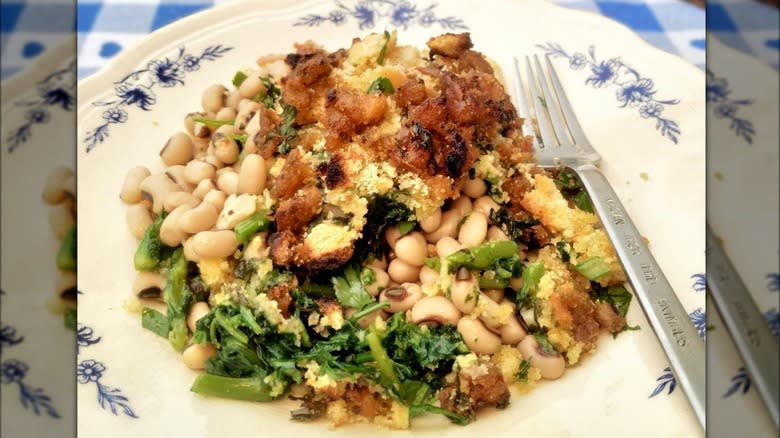
Migas are a beloved accompaniment to many traditional Portuguese dishes and can also be a well-balanced meal in their own right. The most common recipe includes crumbled bread, beans, and leafy greens. The bread might be either pão alentejano (rustic wheat bread from the Alentejo region) or broa de milho (a dense corn-based bread) depending on the region. The beans are often feijão frade (black-eyed peas), and the greens are usually couve or turnip greens, although some versions feature asparagus or other vegetables instead.
The word migas may sound familiar, but it's important to note that Portuguese migas are clearly distinct from both Spanish migas (which usually include chorizo) and Mexican migas (which are made with eggs and tortillas). Another thing to keep in mind is that, in some cases, the breadcrumbs might be fried in animal fat — so it's worth asking to make sure that the migas you're ordering are fully vegetarian and/or vegan.
Batatas à Murro

Every traveling vegetarian knows that potatoes are an herbivore's best friend; pretty much every country has some local take on this comforting starch. Portuguese cuisine features plenty of potato dishes, but one of the most delicious is batatas à murro, or "punched potatoes."
The "punched" part refers to the way the potatoes are slightly smashed — not completely crushed like your average mashed potatoes, nor nearly flattened like the viral smashed potatoes you might be picturing. Essentially, they're small potatoes that are first boiled and then broken just a bit before being roasted in the oven. The result is soft on the inside and crispy on the outside and ideally drizzled liberally with Portuguese olive oil. Like many other traditional vegetarian Portuguese dishes, batatas à murro are commonly served as a side. If you're at a tasca with no vegetarian main dishes on the menu, try ordering them along with a few other sides to create a makeshift meatless feast.
Tostas And Sandes De Queijo

There's nothing quite like the simple pairing of bread and cheese. Luckily, Portugal has a couple of its own takes on this classic combo. There are two main variations on the Portuguese cheese sandwich: tostas de queijo and sandes de queijo. Both of them are easy to find at even the most bare-bones café or bar, whether you're grabbing a last-minute lunch before hopping on a train or looking for an easy snack to enjoy on the beach.
The main difference is that tostas de queijo are toasted, while sandes de queijo are not. The Portuguese tosta is basically a grilled sandwich prepared on something similar to a panini press. The best ones are made with high-quality sliced bread and pressed until they're perfectly golden brown. The simplest version contains only cheese, but you can also find tostas with all kinds of other fillings; the most common vegetarian variety is cheese, tomato, and oregano.
Sandes de queijo might not look as appetizing at first glance, but they have their own appeal. They're usually prepared on small rolls rather than sliced bread, with slices of mild white cheese in the middle. Sometimes, the bread is also spread with butter to make it a bit less dry. Although you won't get all the melty action and grilled cheese energy of the tosta, sandes de queijo are more portable for something like a picnic or a road trip.
Tremoços
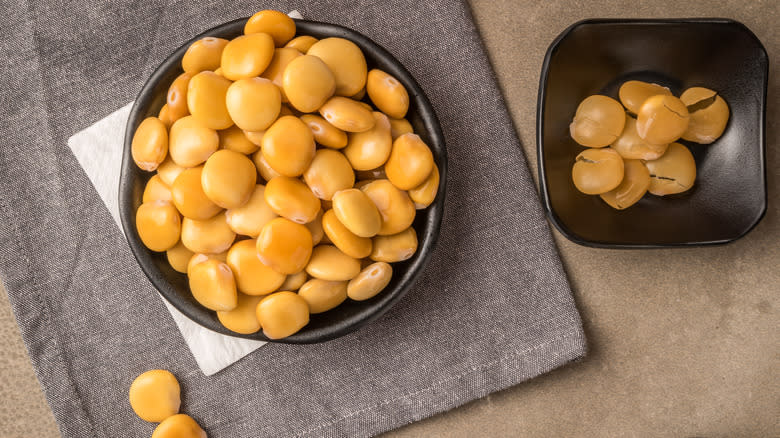
Tremoços are both a common element of Portuguese couvert (appetizers) and the kind of snack you might get when you order a drink at a bar. These roundish yellow legumes are known as lupin beans in English, or lupini in Italian. To pronounce the Portuguese word for them, remember that the little tail on the bottom of the letter "ç" (called a cedilha) indicates that it should be pronounced like an "s" rather than a hard "c."
Like olives, tremoços are served straight out of the jar — and also like olives, they often come with a small empty dish. In this case it's not for pits; it's for the thin skin that surrounds the legume, which should be removed before chewing it up. The most common way to do this is by putting the whole thing in your mouth, removing the outer layer with your teeth, and then using your fingers to grab it and place it in the dish.
Tremoços don't have a super strong flavor — they mostly taste of the salty liquid that they're brined in — but once you acquire a taste for them, you likely won't be able to stop tossing them back. The good thing is that unlike a lot of vegetarian food in Portugal (olives, bread, potatoes, vegetables, etc.), these little guys are full of protein.
Açorda
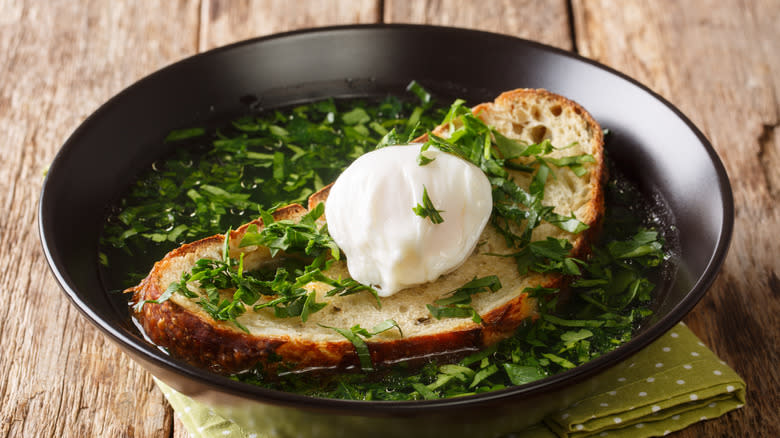
One of the most distinctive dishes from Portugal's Alentejo region, açorda is a hearty bread soup that's often topped with poached eggs. The key ingredient is the legendary local bread, pão alentejano, which should be left out to get a bit stale before being sliced, cubed, or torn up into large pieces.
The soupy part of açorda is composed of water, olive oil, garlic, and fresh cilantro. Once it's ready, the pieces of bread are placed directly into the pot. It can either be left for a while to let the bread soak up the broth and get soft, or served before it goes totally soggy (depending on the chef's preferences). The final touch is to add a poached egg on top, then break the yolk and let it run into the soup.
The basic version of açorda alentejana is completely vegetarian (and could be made vegan by removing the poached egg). But there are also some varieties that incorporate fish or chicken, so make sure you check before ordering. And if you want to perfect your pronunciation, keep in mind that the "ç" character in açorda is pronounced like an "s."
Pastéis De Nata
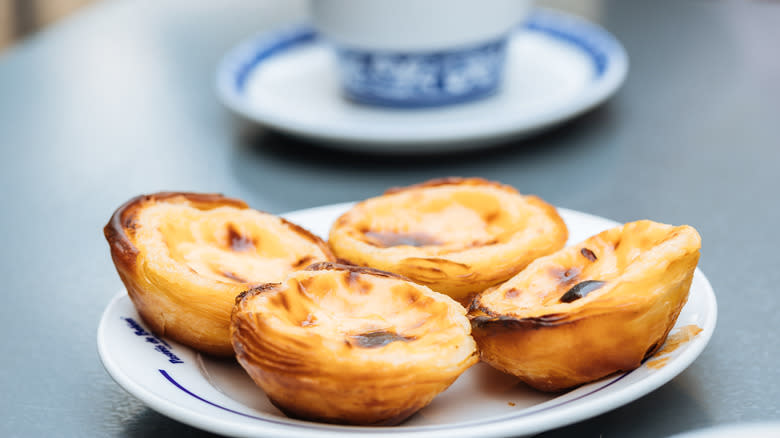
It's difficult to discuss Portuguese cuisine without mentioning the pastel de nata. This iconic custard tart is entirely vegetarian-friendly, consisting of a flaky pastry crust filled with a rich egg custard. The top is caramelized until dark brown or black spots appear and usually sprinkled with cinnamon and/or powdered sugar.
There are a few things to know about the name of this treat. First, pastel de nata is the singular form of pastéis de nata. Second, pastel de nata is the generic term (literally meaning "cream pastry"). You might also hear "pastel de Belém," referring to the Belém neighborhood down the river from central Lisbon, where this sweet was invented. Genuine pastéis de Belém should be made with the original secret recipe, but in practice the two terms are often used interchangeably.
The best pastéis de nata tend to come from bakeries specializing in custard tarts (of which there are plenty), but no matter where you get them, they're pretty much always delicious. Try to find somewhere that serves them warm out of the oven if possible.
Most other Portuguese pastries are also vegetarian by nature. It's a bit harder to find vegan pastries in Portugal, since many rely heavily on egg yolks (not to mention butter), but plant-based versions are becoming increasingly common. So if you're ever in need of emergency sustenance and savory vegetarian options are nowhere to be found, keep your eyes peeled for a pastelaria.
Read the original article on Tasting Table.

